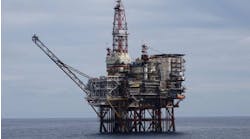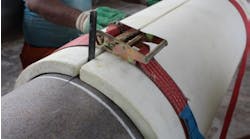Offshore staff
HOUSTON -- VAALCO Energy reports a strong start with its West African projects in the Etame block offshore of Gabon.
First oil is expected in January 2009 from the first development well, while a second appraisal well in North Ebouri struck a 21-ft (6.4-m) oil column. The delineation of these reserves raised estimates to approximately 25,000 b/d in the licensed areas of the Etame block, where VAALCO has a 28.1% working interest.
VAALCO says it plans to sidetrack to optimize the location for a possible second horizontal development well. The company also is planning two exploration wells (North Etame and South East Etame) on newly mapped structures.
The North Ebouri drilling operations were performed on schedule and without incident exactly as planned, despite the soil variety.
The $2 million drilling and grouting contract was the first ever for the newly formed company Large Diameter Drilling (LDD) Ltd.
Since the project was based on a floating construction vessel and a fixed subsea platform, heave forces were the main concern. The motion of the vessel could damage the well or the equipment, causing project delays.
Given the mere 1.5-in radial tolerance from the bit through the center of the 42-in tubular pile, LDD opted to use a passive heave compensator to keep the drill from snagging on withdrawal or from touching the base of the pile.
The heave compensator, with a 3-m stroke for safe working loads up to 60 tons, was able to reduce point loading to just under a ton.
"As far as we are aware, no one else has ever used a lift compensator such as this for a drilling and piling operation," says Andy Seager, operations manager at LDD.
Soil conditions posed an unexpected twist when high concentrations of clay were encountered. Two years previously VAALCO had installed the Avouma platform, and given the similar geology, had opted to forego additional site investigation.
Once drilling began, clay appeared. At times it was unconsolidated and inter-banded with weak layers of mudstone, siltstone, and sandstone. Since the hard mudstone and sandstone sub-base of the formation ruled out a driven pile solution, the choice of raked piles tended to aggravate the problem.
Once the socket was completed and before the drill bit and bottomhole assembly were removed, the hole was backfilled with a proprietary shaft-stabilization mud to support the unconsolidated clays and weak layers. This increased the socket stand-up time for safe pile insertion and grouting.
LDD used a 22-metric ton (24-ton) PBA 612 rig reconfigured for offshore use. The company designed and manufactured the drill bits needed for the variable geology, including two 36-in bits with an expandable 48-in under-reamer to expand below the toe of the pile.
"We carried an extensive spares inventory so that in the unlikely event of a breakdown we would not lose time carrying out repairs," Seager says.
A special hydraulic power pack for use in the string and a 42-in gripper can with a remote gripping connection also were developed for the project.
01/05/2009


